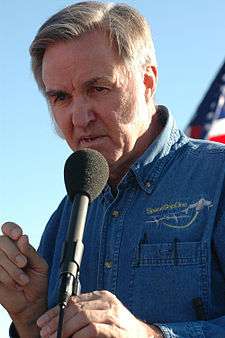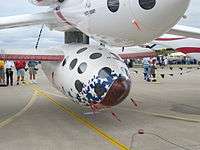Burt Rutan
| Burt Rutan | |
|---|---|
|
Rutan in October 2004 | |
| Born |
June 17, 1943 Estacada, Oregon, U.S. |
| Nationality | United States |
| Education | California Polytechnic State University |
| Occupation | Aerospace engineer & entrepreneur |
| Years active | 1968–2015 |
| Known for | Rutan Voyager, SpaceShipOne, Virgin Atlantic GlobalFlyer, Rutan VariEze and Long-EZ, Scaled Composites founder, The Spaceship Company co-founder, pioneer of composite homebuilts |
| Spouse(s) | Tonya Rutan |
| Parent(s) | George and Irene Goforth Rutan |
| Relatives |
Dick Rutan Nell Rutan |
| Awards |
Living Legend of Aviation (2011) Daniel Guggenheim Medal (2011) Wright Brothers Memorial Trophy (2015) |
Elbert Leander "Burt" Rutan (born June 17, 1943) is an American aerospace engineer noted for his originality in designing light, strong, unusual-looking, energy-efficient aircraft. He designed the record-breaking Voyager, which was the first plane to fly around the world without stopping or refueling, and the sub-orbital spaceplane SpaceShipOne, which won the Ansari X-Prize in 2004 for becoming the first privately funded spacecraft to enter the realm of space twice within a two-week period. With his VariEze design, Rutan is responsible for popularizing the canard configuration and moldless composite construction for homebuilt aircraft.
He has designed 46 aircraft throughout his career, been the co-recipient of the Collier Trophy on two separate occasions, received six honorary doctoral degrees and has won over 100 different awards for aerospace design and development.[1][2] Rutan has five aircraft on display in the National Air and Space Museum in Washington, D.C., United States: SpaceShipOne, the Virgin Atlantic GlobalFlyer, Voyager, Quickie, and the VariEze.[3]
Life and career
Born in 1943 in Estacada, Oregon, 30 miles southeast of Portland, and raised in Dinuba, California, Burt Rutan displayed an early interest in aircraft design. By the time he was eight years old he was designing and building model aircraft. His first solo flight piloting an airplane was in an Aeronca Champ in 1959. In 1965 he graduated third in his class from the California Polytechnic State University (Cal Poly-San Luis Obispo) with a BS degree in aeronautical engineering.[4][5]
From 1965 to 1972 Rutan was a civilian flight test project engineer for the U.S. Air Force at Edwards Air Force Base, working on nine separate projects including the LTV XC-142 VSTOL transport and spin tests of the McDonnell Douglas F-4 Phantom fighter.[6] He left to become Director of Development of the BD-5 aircraft for Bede Aircraft in Newton, Kansas, a position he held until 1974.[7]
In June 1974, Rutan returned to California to establish the Rutan Aircraft Factory. In this business he designed and developed prototypes for several aircraft, mostly intended for amateur builders. His first design, executed while he was still at Bede, was the VariViggen, a two-seat pusher single-engine craft of canard configuration. The canard would become a feature of many Rutan designs, notably the very popular VariEze and Long-EZ.[8]
In April 1982, Rutan founded Scaled Composites, LLC, which has become one of the world's pre-eminent aircraft design and prototyping facilities. Scaled Composites is headquartered in Mojave, California, at the Mojave Air & Space Port.[9] That same year, Beechcraft contracted Rutan's Scaled Composites to refine the design and build the prototype Beechcraft Starship.
In 1995 Rutan was inducted into the National Aviation Hall of Fame in Dayton, Ohio, in 2004 he was listed as one of Time magazine's "100 Most Influential People in the World",[10] and in 2005 he received the NAS Award in Aeronautical Engineering from the National Academy of Sciences.[11]
In a 2010 interview, Rutan articulated his motivation for developing suborbital technology projects with SpaceShipOne and SpaceShipTwo. He was developing suborbital spaceflight technology because in this "we can achieve some breakthroughs," making such flight "orders of magnitude safer and orders of magnitude more affordable. I'm taking this step because I think achieving something that has never existed in manned spaceflight – and that is high volume and public access – I think it is important to do that and to do it as soon as possible."[12]
Rutan is married to Tonya Rutan.[13] He retired from Scaled Composites in April 2011. That same year, he became recognized as a Living Legend of Aviation, receiving the Bob Hoover Freedom of Flight Award. In 2012, Rutan spoke on "Innovation and the Space Race" to the World Affairs Council, as recorded on C-Span.[14] Flying magazine ranked him at number 18 on their 2013 list, "51 Heroes of Aviation".[10] Rutan was also a recipient of the prestigious Wright Brothers Memorial Trophy in 2015.[15]
Aircraft designs
In a 45-year career, each of Rutan's designs have often been quite dissimilar from their predecessors. "His airplanes and spacecraft take on all types of sleek shapes and sizes, looking more like the work of a sculptor than an engineer. In all, Rutan has come up with 367 individual concepts — of which 45 have flown."[16]
Homebuilts
VariViggen and VariViggen SP
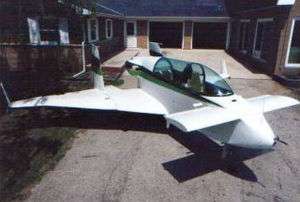
In 1968, he began building his first design, the VariViggen, which first flew in April 1972. It had the rear wing, forward canard, and pusher configuration design elements which became his trademarks.[8] In lieu of wind tunnel testing, Rutan developed aerodynamic parameters for the VariViggen using a model rigged atop his station wagon, and measured the forces while driving on empty roads.
The VariViggen was the Rutan model 27. A new set of outer wings, with winglets, was later developed by Rutan for the VariViggen, producing the VariViggen SP, Rutan model 32. The VariViggen was named in honor of the Saab 37 Viggen, a canard-configured fighter jet developed in Sweden. One VariViggen, built in France and named Micro Star, was powered by two Microturbo TRS-18 jet engines in lieu of the usual piston engine.[17]
VariEze and Long-EZ
The VariViggen design led to the successful[16] Rutan VariEze (pronounced "very easy")[16] homebuilt experimental aircraft designs, in which he pioneered the use of moldless glass-reinforced plastic construction in homebuilts. The prototype made its public debut at the 1975 EAA Convention and Fly-In (now called AirVenture) in Oshkosh, Wisconsin.[18] That same year, his brother Dick Rutan set a world distance record in the under-500 kg (1100 lb) class in the VariEze,[19] and these aircraft went on to set other world records in this class.[20] They were also the first aircraft to fly with NASA-developed winglets.[21] The Long-EZ had a range of 2,010 miles (3,230 km), over twice that of the VariEze.[16]
.jpg)
Rutan later revised the VariEze design, providing more volume for fuel and cargo, resulting in the Rutan model 61 Long-EZ, designed to be powered by a Lycoming O-235, although some have used Lycoming O-320s or Lycoming O-360s. The Long-EZ also has a revised wing spar design that is not subject to the 2.5 g positive, 1.5 g negative, maximum load factor limit applied to the VariEze after the discovery of problems with some VariEze wings.[22]
Quickie
Rutan was approached by Gene Sheehan and Tom Jewett to develop a single-seat personal sport aircraft. Following a preliminary canard project (model 49), a tandem wing configuration was eventually designed, to be powered by an 18 hp Onan industrial engine. The prototype (Rutan model 54) was built in 1977 and registered as N77Q. After 5 months of testing, Quickie Aircraft marketed the aircraft as the Rutan model 54 Quickie in 1978.
Two derivatives of the Quickie were subsequently developed, both expanded to include two seats. Quickie Aircraft had Gary LaGare develop the Q2, while Viking Aircraft developed the Viking Dragonfly.[23]
Solitaire
The Sailplane Homebuilders Association (Now the Experimental Soaring Association) opened a competition for a homebuilt, self-launching sailplane. Rutan designed the model 77 Solitaire for this competition, which it won. The sailplane was canard-configured, with a retractable engine ahead of the cockpit.[24]
Research aircraft
ARES Also called the Mudfighter, ARES is a full-size flying and shooting prototype of a lightweight low cost aircraft with a similar ground attack, ground support role as the A-10.
Grizzly
Rutan designed the model 72 Grizzly to investigate the possibility of a STOL canard aircraft. It was retired after testing.[25]
Lotus Microlight
Rutan was approached by Colin Chapman, the founder of Lotus Racing, to design a single-seat ultralight aircraft. Again, a canard configuration was developed, the Rutan model 91. Colin Chapman's untimely death brought this project to an end, after the aircraft had flown.[26]
Ames AD-1
In the 1980s NASA issued a contract to Ames Industrial Company of Bohemia, New York to develop a small, low-cost aircraft to investigate Robert T. Jones's (a NASA researcher at NASA's Ames Research Center) oblique wing concept. Ames turned to Rutan, who designed a small, fiberglass airframe, powered by two Microturbo TRS-18 jet engines. This was the Rutan model 35, the Ames AD-1. After completion of the test program, the AD-1 was retired and is now on exhibit in the Hiller Aviation Museum in San Carlos, California.[27]
Boomerang
A departure from the canard design was the Rutan Boomerang, perhaps one of the unconventional designer's most unconventional aircraft. The aircraft, the model 202 Boomerang, is an asymmetric twin-engine tractor configuration aircraft with one engine on the fuselage and another mounted on a pod. A November 1996 Popular Mechanics feature article said it "looks more like a trimotor that lost its right boom and engine".[28]
BiPod
Rutan's most recent design, BiPod, is a hybrid flying car. Announced in July 2011, the twin-pod vehicle has a wingspan of 31 feet 10 inches; with the wings reconfigured (stowed between the pods), the car has a width of 7 feet 11 inches and fits in a single-car garage. The design has two 450 cc four-cycle engines, one in each pod, which power a pair of generators that in turn power the electric motors used for propulsion. "Lithium-ion batteries in the nose of each pod will provide power during take off and an emergency backup for landing. With a cruising speed of 100 miles per hour (160 km/h), Scaled Composites says the BiPod 367 would have a range of 760 miles (1,220 km)." The plane can fly at 200 miles per hour (320 km/h) which reduces the range to 530 miles (850 km). "Out on the road, this roadable aircraft, which carries 18 US gallons (68 l; 15 imp gal) of fuel, is expected to have a driving range of 820 miles. It has a claimed electric-only range of 35 miles."[29] Flight controls are in the right pod, road controls (steering wheel and brakes) in the left.[30]
Performance aircraft
Amsoil Racer The Rutan model 68 Amsoil Racer is a racing aircraft of Quickie configuration (1981).
Voyager
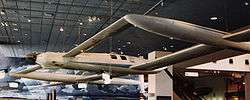
Rutan was approached by his brother Dick about designing an airplane that could fly nonstop, unrefueled around the world, something that had never been done before.[31] Around-the-world flights had been accomplished by military crews using in-flight refueling.[32]
Burt developed a twin-engined (piston engines, one pusher and one tractor) canard-configured design, the Rutan model 76 Voyager. The pusher engine ran continuously, the tractor engine was used for take-off and initial climb to altitude, then was shut down.[33][34]
The aircraft was first flown with two Lycoming O-235 engines. After development work, it was reengined with a Continental O-200 (modified to include liquid cooling) as the pusher engine and a Continental O-240 as the tractor engine.[35]
As a proving flight, Dick and his partner Jeana Yeager made a record setting endurance flight off the coast of California. In December 1986, they took off from Edwards Air Force Base in California and flew around the world (westward) in nine days, fulfilling the aircraft's design goals. The Voyager was retired and now hangs in the Milestones of Flight exhibit in the National Air and Space Museum (NASM) main exhibit hall,[36] with the Wright Flyer, Spirit of St. Louis and Bell X-1.
Burt and Dick Rutan, along with Yeager, received the Presidential Citizens Medal from Ronald Reagan and the Collier Trophy for their efforts as the Voyager team.
Catbird
Desiring a new personal airplane, Rutan designed a five-seat, single-engined pressurized airplane, the Model 81 Catbird. The airplane was configured as a three-surface aircraft (canard, main wing, and tail). After serving as Rutan's personal airplane, it was retired. The Catbird is notable for winning the CAFE Challenge aircraft efficiency prize in 1993.[37]
Pond Racer
Concerned about the dwindling numbers of World War II aircraft, with many being consumed by use as Unlimited Class racers at the Reno Air Races, Bob Pond contracted Scaled to design an Unlimited Class racer. The result was the Pond Racer. After design studies, a twin-engined, conventional configured layout was chosen. The aircraft was powered by two 1000 hp Electromotive-Nissan VG-30 3-liter GTP piston engines running on methanol. The aircraft was built and tested before delivery to the customer. It appeared at the Reno Air Races in 1991, 1992 and 1993. The aircraft was destroyed in a forced landing crash on September 14, 1993, killing pilot Rick Brickert.[38]
Proteus
The Model 281 Proteus is a tandem-wing high-endurance aircraft designed by Rutan to investigate the use of aircraft as high altitude telecommunications relays. The aircraft's requirements were designed by Angel Technologies and Broadband.com. Its first flights were in 1998. It holds several altitude records, set in 2000.[39]
GlobalFlyer
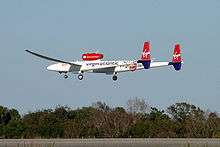
On March 3, 2005, the Virgin Atlantic GlobalFlyer, an aircraft similar to the Voyager design, but built by Rutan's new company Scaled Composites, with stiffer materials and a single jet engine, completed the first solo non-stop, non-refueled flight around the world with adventurer Steve Fossett as pilot. Reducing weight was critical to the design, and Rutan is quoted as facetiously telling his staff that when they finish building a part, they must throw it up in the air for a weight test, and "If it comes down, it's too heavy".[40] Between February 7, 2006 – February 11, 2006, Fossett and the GlobalFlyer set a record for the longest flight in history: 41,467.53 km (25,766.73 mi), the third absolute world record set with this aircraft[41] before being flown to the NASM Steven F. Udvar-Hazy Center. Global Flyer is the sixth vehicle designed by Rutan in the NASM collection.[42]
Contracted aircraft
Triumph
The Scaled Composites Triumph was a twin-engine, business jet prototype designed and built for Beechcraft. The aircraft is a three lifting surface design, with both a small forward wing, and a small conventional horizontal stabilizer in a T-tail configuration.
Visionair Vantage
The VisionAire VA-10 Vantage is a prototype single-engined light business-jet (or "very light jet", also known as VLJ) developed by VisionAire Jets Corporation. In 1996 Rutan designed the first prototype, a proof-of-concept aircraft intended to confirm the design's handling, which resulted in several problems and a redesign of the aircraft in 1998.
V-Jet II
The Williams V-Jet II was a VLJ designed and built as a test bed and demonstrator aircraft for Williams International's new FJX-1 turbofan engine. It served as the design inspiration for the Eclipse 500.
Adam M-309
The Adam M-309 CarbonAero was a technology demonstrator six-seat civil utility aircraft designed by Rutan and built by Scaled Composites. It developed into the A500, which is produced by Adam Aircraft Industries.
Spacecraft designs
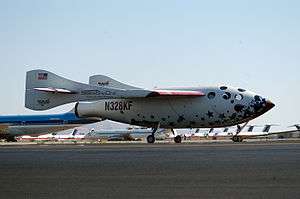
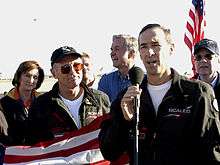

SpaceShipOne
Rutan made headlines again in June 2004 with SpaceShipOne, which became the first privately built, flown and funded manned craft to reach space. The project, named "Tier One" (later known as Tier 1b), was developed and flown by Mojave Aerospace Ventures, a joint venture between Rutan's Scaled Composites and co-founder of Microsoft, Paul Allen. On October 4, SpaceShipOne won the Ansari X Prize, completing two flights within two weeks, flying with the equivalent weight of 3 persons, and doing so while reusing at least 80% of the vehicle hardware. The project team was honored with the 2004 Collier Trophy, awarded by the National Aeronautic Association for "greatest achievement in aeronautics or astronautics in America." The craft embodies Rutan's unique style, and is another of the "icons of flight" displayed in the NASM Milestones of Flight exhibit.[43]
SpaceShipTwo Project
Virgin Galactic—an offshoot of businessman and investor Sir Richard Branson's Virgin Group, and the parent company of Branson and Rutan's 2005 spacecraft manufacturing startup The Spaceship Company—announced that it would begin space tourism flights in 2008 using craft based on the designs of SpaceShipOne. Dubbed SpaceShipTwo, these new craft, also designed by Rutan, are intended to allow six "experience optimized" passengers to glimpse the planet from 70–80 miles up in suborbital space. Production of the first of five planned SpaceShipTwo craft has started, but commercial flights did not begin in 2008 as planned. An explosion at the Scaled Composite factory at the Mojave Spaceport on July 26, 2007, which killed three engineers and seriously injured three others, may have contributed to the delay. They were testing components for SpaceShipTwo, but as of August 2007 Scaled Composites remained dedicated to perfecting the design of SpaceShipTwo.[44] Virgin continues to work on developing SpaceShipTwo, but it has stopped predicting when commercial spaceflights will begin.[45] A further SpaceshipTwo accident on October 31, 2014 (VSS Enterprise tail number: N339SS) resulted in the death of pilot Michael Alsbury and injuries to the copilot.[46]
Rutan was also working with t/Space in the mid-2000s on the development of an air launched, two-stage-to-orbit, manned spacecraft. It was intended to have a taxi capacity to carry passengers to the International Space Station. In June 2005, air drop tests of quarter scale mockups verified the practicality of air release and rotation to vertical.[47]
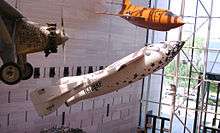
White Knight Two
On July 28, 2008, Richard Branson unveiled Scaled Composites White Knight Two "Eve," at the Mojave Spaceport. The jet-powered cargo aircraft is based on SpaceShipOne's successful mothership, White Knight, which itself is based on Proteus. Flight tests were set to begin in September 2008.[48][49] The launch customer of White Knight Two is Virgin Galactic, which will have the first 2 units, and exclusive rights to the craft for the first few years. In 2008, Branson predicted that the maiden space voyage would take place within 18 months: "It represents... the chance for our ever-growing group of future astronauts and other scientists to see our world in a completely new light." Virgin Galactic contracted Rutan to build the mothership and spacecraft.[50][51]
Anthropogenic climate change skepticism
On July 29, 2009, Rutan drew a full house for his presentation at the Experimental Aircraft Association's EAA AirVenture 2009 Oshkosh Conference entitled "Non-Aerospace Research Quests of a Designer/Flight Test Engineer" where he discussed his thoughts on his hobby of global warming.[52] He then updated and extended his Oshkosh presentations in 2010 and 2011.[53][54]
Admitting in his presentation that he was not a climate scientist, Rutan also acknowledged his bias in favor of technology and against "government expansion":
"I put myself in the (Those who fear expansion of Government control) group, and do not hide the fact that I have a clear bias on Anthropogenic global warming (AGW). My bias is based on fear of Government expansion and the observation of AGW data presentation fraud – not based on financial or any other personal benefit. I merely have found that the closer you look at the data and alarmists’ presentations, the more fraud you find and the less you think there is an AGW problem... For decades, as a professional experimental test engineer, I have analyzed experimental data and watched others massage and present data. I became a cynic; My conclusion – “if someone is aggressively selling a technical product whose merits are dependent on complex experimental data, he is likely lying”. That is true whether the product is an airplane or a Carbon Credit."
He describes his interest on the climate change topic as deriving from his "interest in technology, not tree hugging".
Rutan will also not interview with Scientific American, as he claimed that the magazine has "...improperly covered man-made global warming. They drink Kool-Aid instead of doing research. They parrot stuff from the IPCC and Al Gore."[55]
Retirement
On November 3, 2010, Scaled Composites announced the retirement of Rutan:
"Burt Rutan, founder of aerospace research firm Scaled Composites in 1982, has announced his plans to retire in April 2011. He currently serves as Scaled’s chief technical officer and, following his retirement, Burt will assume the title of founder and chairman emeritus. Burt has worked in California's Antelope Valley for more than 45 years, initially as flight test project engineer for the Air Force and in 1974 he founded the Rutan Aircraft Factory to develop experimental aircraft for homebuilders."[56]
“Burt is known worldwide as a legendary genius in aircraft design in the aviation world. I am very fortunate and proud to have worked by his side for the past 28 years,” says President Douglas B. Shane. “We wish Burt and his wife, Tonya, the very best the future holds for them.”[56]
On April 1, 2011, Rutan retired from Scaled Composites to his home in Coeur d'Alene, Idaho. He said that he is working on one more innovative design.[16] In July 2011, this was revealed to be a hybrid flying car, the Model 367 BiPod.[29]
Working as an individual out of his home in retirement, in 2015 he began water and flight testing a prototype of a new amphibian aircraft, the Rutan SkiGull, intended to be capable of flying between Hawaii and California, cruising at 200 mph, taking off or landing in about 400 feet on challenging surfaces including rough terrain, seas, grass, snow, or ordinary runways, fueled by ordinary automotive or marine gasoline, and having small electric motors for power assists or emergency landing.[57][1][58][59]
See also
- Hugo Junkers, German engineer and aircraft designer, considered the first aerospace airframe materials innovator, with the all-metal J 1 in 1915
- Klapmeier brothers, founders of Cirrus Aircraft, inaugurated major change in production airframe manufacturing, with the all-composite SR20 in 1999
- Paul Poberezny, founder of the Experimental Aircraft Association and EAA Annual Convention & Fly-In, designed and built several homebuilt aircraft
- Rutan Defiant, with twin push-pull engines & 4 seats
- Black Sky: The Race For Space, a documentary about him and SpaceShip One.
References
- 1 2 Collin Krum. "Burt Rutan's SkiGull Could Be His Last Creation And Most Versatile Ever". Flight Club.
- ↑ "Awards". BurtRutan.com.
- ↑ "eroRutan Quickie". si.edu.
- ↑ "Burt Rutan, Curriculum Vitae". Royce Carlton Inc. April 2005. Retrieved July 8, 2009.
- ↑ "Science, Technology and Society 2002–2003 Resident Scholar Program biography". Institute for Science, Engineering and Public Policy. Retrieved July 8, 2009.
- ↑ "Burt Rutan to Receive Heinlein Award for Lifetime Achievement in Aerospace". National Space Society. April 15, 2008. Retrieved July 8, 2009.
- ↑ Template:BD-5 FLIGHT TEST PROGRAM REPORT, Lester H. Berven, Chief Test Pilot – BEDE AIRCRAFT, INC.
- 1 2 M.S.Rajamurthy. "Rutan – The Canard Guru" (PDF). National Aerospace Laboratories, India. Retrieved July 8, 2009.
- ↑ "Printable map to Scaled Composites". Scaled Composites, LLC. Retrieved July 8, 2009.
- 1 2 Flying – 51 Heroes of Aviation http://www.flyingmag.com/photo-gallery/photos/51-heroes-aviation?pnid=41836
- ↑ "J. C. Hunsaker Award in Aeronautical Engineering". National Academy of Sciences. Retrieved February 14, 2011.
- ↑ Burt Rutan, Aerospace Engineer, BigThink, interview with Burt Rutan, March 3, 2010, accessed March 6, 2010. Video segment at 8:40 ff.
- ↑ Leonard David (September 27, 2004). "Set to Soar: First X Prize Flight This Week". Space.com. Retrieved July 8, 2009.
- ↑ "Innovation Space Race - Video - C-SPAN.org". C-SPAN.org.
- ↑ Megan Elliot (October 2015). "Burt Rutan Wins 2015 Wright Trophy". Flyingmag.com. Retrieved January 16, 2015.
- 1 2 3 4 5 W.J. Hennigan (April 1, 2011). "Aerospace legend Burt Rutan ready for a landing". Los Angeles Times. Retrieved 2011-04-02.
Five of his planes now hang in the Smithsonian National Air and Space Museum, including the Voyager, which in 1986 became the first airplane to fly around the world without refueling, and SpaceShipOne, which in 2004 became the first private rocket plane ever to put a man into space. … Rutan has been the subject of documentaries, magazine covers and the CBS newsmagazine "60 Minutes." … For more than 45 years, Rutan has worked … designing aircraft unlike any other that preceded it. His airplanes and spacecraft take on all types of sleek shapes and sizes, looking more like the work of a sculptor than an engineer. In all, Rutan has come up with 367 individual concepts — of which 45 have flown.
- ↑ "Micro Star". The Price of Passion – Minijets. Retrieved December 7, 2009.
- ↑ EAA Aviation Center (n.d.). "1975 Rutan VariEze Prototype – N7EZ". Retrieved 2014-11-08.
- ↑ "FAI Record ID #1898 – Distance over a closed course" Fédération Aéronautique Internationale (FAI). Retrieved: September 14, 2014.
- ↑ List of records established by the 'Rutan VariEze' Archived May 12, 2006, at the Wayback Machine.. Accessed January 5, 2006.
- ↑ Winglets by Gail S. Langevin of NASA. Accessed January 5, 2006.
- ↑ RAF service bulletin published on www.cozybuilders.org. Accessed February 20, 2010.
- ↑ Dave Morris. "Dragonfly FAQ". Dave Morris' Dragonfly Page. Retrieved July 8, 2009.
- ↑ "Archived copy". Archived from the original on May 18, 2009. Retrieved 2009-07-08. Sailplanedirectory.com entry
- ↑ "AirVenture Museum: Rutan Grizzly 72 – N80RA". EAA Aviation Center. Retrieved July 8, 2009.
- ↑ "AutoWeek Burt Rutan and Colin Chapman Article". Lotus Talk (forum). September 28, 2004. Retrieved July 8, 2009.
- ↑ "Hiller Aviation Museum Briefing" (PDF). Retrieved October 27, 2006.
- ↑ Boomerang! Archived December 10, 2006, at the Wayback Machine.. Accessed January 5, 2006.
- 1 2 Paur, Jason (2011-07-18). "Burt Rutan Designs a Hybrid Flying Car". Wired. Retrieved 2011-07-27.
The gasoline-electric twin-pod vehicle has a range of 760 miles in the air and 820 miles on the ground, and it works a bit like a Chevrolet Volt. Electric motors provide propulsion, while two gasoline engines drive generators that keep the juice flowing. Design No. 367 — the craft is named in accordance with the simple numbering system long used by Rutan — was unveiled [in July 2011] after making its first short hop in the air on March 30. It is the legendary aerospace designer’s final project at Scaled Composites, the company he founded in 1982.:
- ↑ Editorial staff (January 2012). "Design by Rutan: 39 years, 37 Airplanes, 1 Spaceship". Air & Space Smithsonian., pp. 42-51.
- ↑ "Rutan Voyager". si.edu.
- ↑ For example, the Lucky Lady II made an around the world flight from February 26, 1949 to March 2, 1949."AF.mil – History Milestones". Archived from the original on October 20, 2012. Retrieved June 20, 2010.
- ↑ "Burt Rutan". Plane Spotting World. April 9, 2008. Retrieved July 8, 2009.
- ↑ Jackson, Robert (2004). The Encyclopedia of Aircraft. Thunder Bay Press. pp. 426–27.
- ↑ "Rutan Voyager". si.edu.
- ↑ "Rutan Aircraft Designs". US Centennial of Flight Commission. Retrieved July 8, 2009.
- ↑ CAFE Foundation
- ↑ Fitzgerald. "AIRPLANE PAGE". Retrieved July 8, 2009.
- ↑ FAI world aviation records database, accessed August 30, 2008
- ↑ David Noland (February 2005). "Burt Rutan and the Ultimate Solo". Popular Mechanics.
- ↑ List of records established by the 'Scaled Composites M311' Archived May 2, 2006, at the Wayback Machine.. Accessed January 5, 2006.
- ↑ National Air and Space Museum to Welcome Steve Fossett’s History-Making Airplane for Permanent Display at Steven F. Udvar-Hazy Center. Accessed January 5, 2006.
- ↑ SpaceShipOne Joins the Icons of Flight on Display at Smithsonian's National Air and Space Museum Archived December 2, 2006, at the Wayback Machine.. Accessed January 5, 2006.
- ↑ Doligosa Felix, Jr. (July 27, 2007). "Query into tragic test begins : But finding the cause of the deadly blast may take up to six months, officials say>". Kern County news. Archived from the original on September 27, 2007. Retrieved July 29, 2007.
- ↑ Simon, Stephanie; Pasztor, Andy (September 1, 2011). "Slow Liftoff for Space Tours". The Wall Street Journal. Archived from the original on September 3, 2011.
- ↑ Malik, Tariq (December 2014). "Virgin Galactic SpaceShipTwo Crash: Full Coverage and Investigation". Space.com. Retrieved May 1, 2015.
- ↑ David, Leonard (June 15, 2005). "t/Space Tests Air-Launch Passenger-Carrying Rocket Concept". Space.com. Retrieved October 17, 2010.
- ↑ "2008 AirVenture Oshkosh schedule". Retrieved July 19, 2008.
- ↑ Leonard David (June 6, 2008). "Virgin Galactic Spaceline: Mega-Mothership Set for Rollout Debut". SPACE.com. Retrieved June 10, 2008.
- ↑ "BBC NEWS - Science & Environment - Branson unveils space tourism jet". bbc.co.uk.
- ↑ Rachel Courtland, Oshkosh. "Virgin Galactic rolls out SpaceShipTwo's 'mothership' - New Scientist". New Scientist.
- ↑ "EAA AirVenture Oshkosh - Oshkosh, Wisconsin - Fly-In & Convention". airventure.org.
- ↑ Burt Rutan, An Engineer's Critique of Global Warming "Science‟, July 2010 Oshkosh
- ↑ Burt Rutan, An Engineer's Critique of Global Warming "Science" Ver 4.3 Jan. 2011
- ↑ Cohen, David. The Maverick of Mojave (Opinion Interview), New Scientist, January 30, 2010, Issue 2745, pg.26. Retrieved via NewScientist.com March 10, 2010.
- 1 2 "Burt Rutan Announces Retirement Plans" (PDF) (Press release). Scaled Composites. November 3, 2010.
- ↑ http://www.aopa.org/News-and-Video/All-News/2015/July/22/SkiGull-Details-Revealed
- ↑ "Rutan's SkiGull - First Flight". eaa.org.
- ↑ Miquel Ros, for CNN (February 22, 2016). "Sky pioneers: A light aircraft revolution is taking off". CNN.
External links
| Wikiquote has quotations related to: Burt Rutan |
- The Ultimate Online Resource on Every Known Rutan Project
- Chrysler Design Award webpage
- Online biography
- Biography from House Committee on Science
- National Aviation Hall of Fame biography
- Burt Rutan at TED

- "The real future of space exploration" (TED2006), Monterey, CA; recorded February 2006 (duration: 20 min)
- SpaceShip One
- Rutan talk at the 2012 "The UP Experience" conference, Houston, Texas; recorded October 25, 2012 (duration: 26 min)
Articles
- The Designer: Burt Rutan
- Burt Rutan: Icon of Homebuilding and Space Travel
- The wit and wisdom of Burt Rutan
